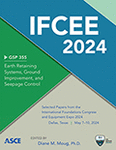Feasibility of Using Liquid Polymer to Grout Soil with High Fine Contents
Publication: IFCEE 2024
ABSTRACT
For a long time, grouting predominantly uses cementitious materials to fill voids and/or create bonding between soil particles, which in general have been performing well in highly permeable soil, such as sands and gravels. However, for soil with low permeability, for example, fine grain soil or coarse grain soil with high fine contents, cementitious materials typically are not applicable due to low flowability. Water-activated polymer (WAP) may be an excellent alternative to cementitious material to expand the groutable spectrum of soils. Among many types of WAPs, this study uses a polymer precursor that is liquid and has a viscosity as low as 25 centipoise, which means it is as flowable as low fat milk. In addition, WAP is made of macro-molecules, and the size of molecules is in the scale of nanometer, which makes them much smaller than cement particles. Therefore, using WAP to replace traditional cementitious materials as grouting materials has great potential to expand the application to fine-grain soils. This study focuses on studying the viscosity of WAP during its curing process as well as its penetration capacity for different pore sizes. The viscosity was measured by a viscometer under a controlled-temperature environment, while the penetration was measured by micro-filteration membrane with sub-micron pores. The results indicate that during the curing process, the viscosity experienced three phases of change: first increase and then decrease and finally increase again. As to penetration, the WAP can easily penetrate through micro-membranes with a pore size of 0.22 μm. Based on the test results, a preliminary estimation of the groutability was performed based on the existing pore size model. It showed that it can be used in many fine-grain soils, which are considered ungroutable for cementitious materials.
Get full access to this chapter
View all available purchase options and get full access to this chapter.
REFERENCES
Akbulut, S., and Saglamer, A. (2002). “Estimating the groutability of granular soils: a new approach.” Tunnelling and Underground Space Technology, 17, 371–380.
ASTM. (2022). Standard test method for viscosity determination of asphalt at elevated temperatures using a rotational viscometer. American Society for Testing and Materials.
Avci, E., and Mollamahmutoğlu, M. (2016). “UCS Properties of Superfine Cement–Grouted Sand.” J. Mater. Civ. Eng., 28(12), 06016015-06016011 - 06016019.
Baker, W. H. (1982). “Planning and performing structural chemical grouting.” Grouting in Geotechnical Engineering, W. H. Baker, ed., ASCE, New York.
Bell, F. G. (1993). Engineering Treatment of Soils, E&FN Spon, London.
Burwell, E. B. (1958). “Cement and clay grouting of foundations: practice of the corps of engineering.” J. Soil Mech. Foundation Div., 84, 1551/1551–1551/1522.
Chang, C.-C., and Cheng, D.-H. (2018). “Predicting the soil water retention curve from the particle size distribution based on a pore space geometry containing slit-shaped spaces.” Hydrology and Earth System Sciences, 22, 4621–4632.
Christopher, B. R., Atmatzidis, D. K., and Krizek, R. J. (1989). “Laboratory testing of chemically grouted sand.” Geotech. Test. J., 12(2), 109–118.
Clough, G. W., Kasali, G., and Kuck, W. (1979). “Silicate-stabilized sands.” J. Geotech. Eng. Div., Am. Soc. Civ. Eng., 105(1), 65–82.
Eklund, D., and Stille, H. (2008). “Penetrability due to filtration tendency of cement-based grouts.” Tunn. Undergr. Space Technol., 23(4), 389–398.
Farhadian, H., and Maleki, Z. (2023). “Groutability classification of granular soils with cement grouts.” Journal of Rock Mechanics and Geotechnical Engineering Journal, 15, 1580–1590.
Hamamoto, S., Moldrup, P., Kawamoto, K., Jonge, L. W. D., Schjønning, P., and Komatsu, T. (2011). “Two-region extended archie’s law model for soil air permeability and gas diffusivity.” Soil Sci. Soc. Am. J., 75, 795–806.
Incecik, M., and Ceren, I. (1995). “Cement grouting model tests.” Bulletin of The technical University of Istanbul, 48(2), 305–317.
Karol, R. H. (1990). Chemical Grouting, Marcel Dekker, Inc., New York.
Markou, I. N., Christodoulou, D. N., and Petala, E. S. (2018). “Injectability of microfine cement grouts into limestone sands with different gradations: experimental investigation and prediction.” Geotech Geol Eng 36, 959–981.
Markou, I. N., and Litsiou, A. E. “Efficiency of soil groutability criteria for cement suspension grouting.” Proc., Geotechnical Engineering Foundation of the Future: the XVII ECSMGE-2019.
Mitchell, J. K. (1981). “Soil Improvement: State-of-the-Art.” 10th International Conference on Soil Mechanics and Foundation EngineeringStockholm Sweden.
Ozgurel, H. G., and Vipulanandan, C. (2005). “Effect of grain size and distribution on permeability and mechanical behavior of acrylamide grouted sand.” Journal of Geotechnical and Geoenvironmental Engineering, 131(12), 1457–1465.
Rezaeimalek, S., Huang, J., and Bin-Shafique, S. (2017). “Evaluation of curing method and mix design of a moisture activated polymer for sand stabilization.” Construction and Building Materials, 146, 210–220.
Sakaki, T., Komatsu, M., and Takahashi, M. (2014). “Rules-of-Thumb for predicting air-entry value of disturbed sands from particle size.” Soil Sci. Soc. Am. J., 78, 454–464.
Spagnoli, G. (2021). “A review of soil improvement with non-conventional grouts.” International Journal of Geotechnical Engineering, 15(3), 273–287.
Vipulanandan, C., and Ozgurel, H. G. (2009). “Simplified relationships for particle-size distributionand permeation groutability limits for soils.” Journal of Geotechnicaland Geoenvironmental Engineering, 135(9), 1190–1197.
Warner, J. (2004). Practical Handbook of Grouting: Soil, Rock, and Structures, Wiley, Hoboken, New Jersey.
Information & Authors
Information
Published In
History
Published online: May 3, 2024
ASCE Technical Topics:
- Cement
- Concrete
- Construction engineering
- Construction methods
- Engineering materials (by type)
- Fine-grained soils
- Fluid mechanics
- Geomechanics
- Geotechnical engineering
- Grouting
- Hydrologic engineering
- Materials engineering
- Permeability (soil)
- Polymer
- Soil cement
- Soil grouting
- Soil mechanics
- Soil properties
- Soils (by type)
- Synthetic materials
- Viscosity
- Water and water resources
Authors
Metrics & Citations
Metrics
Citations
Download citation
If you have the appropriate software installed, you can download article citation data to the citation manager of your choice. Simply select your manager software from the list below and click Download.
